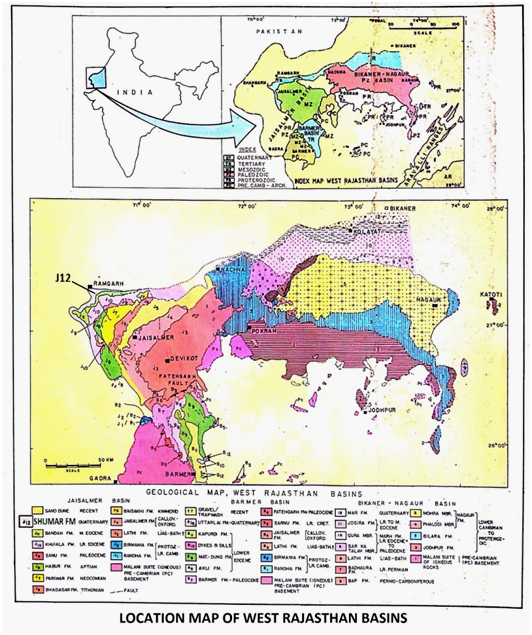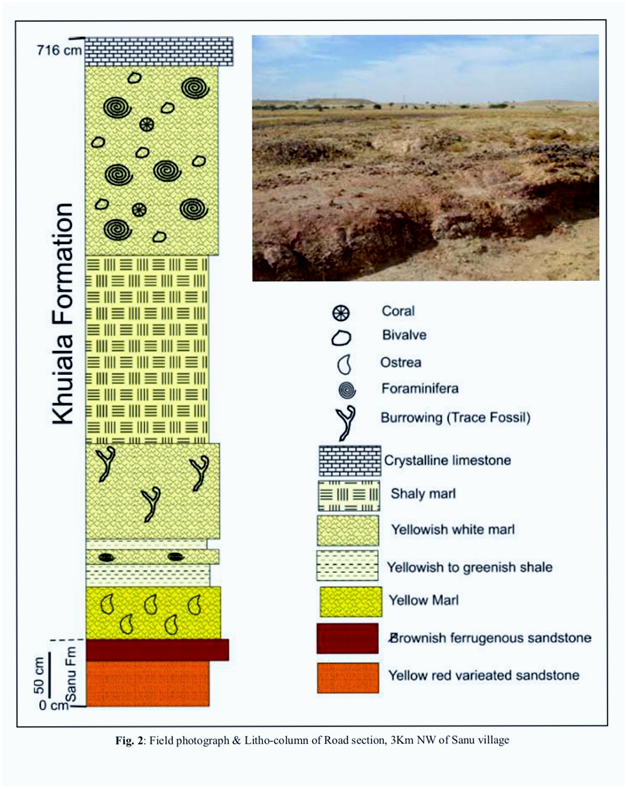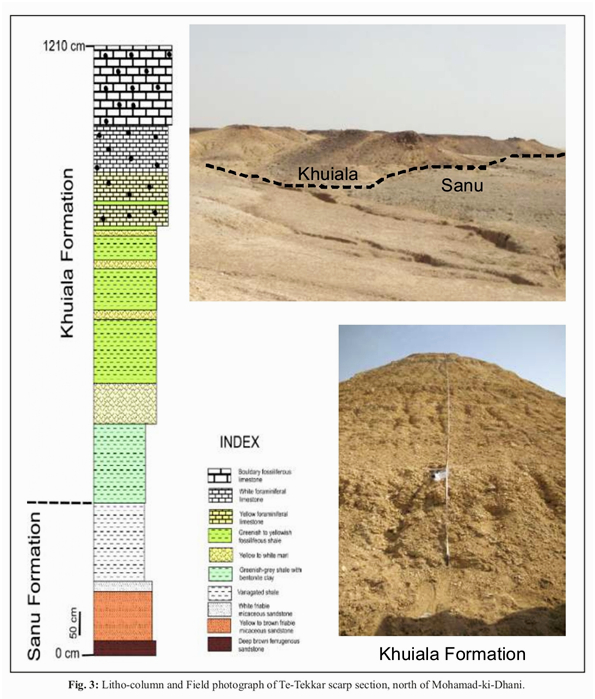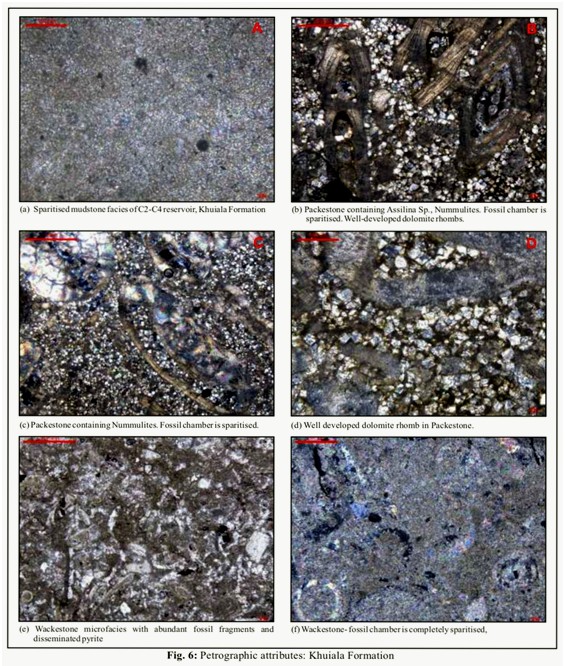Khuiala Fm
Type Locality and Naming
OUTCROP. Narayanan (1959) formally introduced Khuiala Formation for the lower litho-unit after the village Khuiala. Dasgupta (1974) has extended the name Khuiala Formation to subsurface. In the work of Mishra et al., (1993), the nomenclature of Khuiala Formation has been retained. [Original Publication: Narayanan , K. 1959. Progress report on the geological work in Jaisalmer, ONGC report (Unpublished)]. Reference well: Interval 511-791 m in well Kharatar-1
Synonyms: The Eocene limestone beds were first mapped by Oldham (1886) who named them as “Nummulitic Limestone Beds”. Ghosh (1952) and Swaminath et al., (1959) adopted the same nomenclature. However, Dasgupta et al., (1958) differentiated these beds into two litho-units: Lower and Upper, based on their litho-association.
Lithology and Thickness
Gypsiferous claystone and clayey limestone. The type section comprises of gypsiferous clay/shale greenish to cream followed by a grayish white to saffron shale consisting of Assilina. This is overlain by dirty white, thin-bedded argillaceous limestone, yellow to brown hard, shell limestone, white to yellow chalk, occasionally sandy and at the top is pinkish yellow, thick bedded, massive, hard, compact, crystalline and fossiliferous limestone. The Khuiala Formation is fossiliferous both in outcrop and subcrop sections. Based on distinct lithological variation, Singh (1984) has subdivided Khuiala Formation into two members. Te-Takar Limestone Member and Khinsar Shale Member.
[Figure 1: Location map of West Rajasthan Basins (after Pandey and Dave, 1998)]
[Figure 2: Field Photograph and Lithocolumn of Road Section, Facies Analysis, Reservoir Characterization and Depositional Environment study of Hydrocarbon bearing Tertiary Sequences in Jaisalmer Basin, Rajasthan (after R. Pandey et.al., 2019) ONGC Bulletin, Vol. 54, No.1)]
[Figure 3: Lithocolumn and Field Photograph of Te-Tekkar Scarp Section, Facies Analysis, Reservoir Characterization and Depositional Environment study of Hydrocarbon bearing Tertiary Sequences in Jaisalmer Basin, Rajasthan (after R. Pandey et.al., 2019), ONGC Bulletin, Vol. 54, No.1)]
[Figure 4: Petrographic attributes, Facies Analysis, Reservoir Characterization and Depositional Environment study of Hydrocarbon bearing Tertiary Sequences in Jaisalmer Basin, Rajasthan, (after R. Pandey et.al., 2019), ONGC Bulletin, Vol. 54, No.1)]
[Figure 5: Generalized and Subsurface Stratigraphy of Jaisalmer Basin (from dghindia.gov.in)]
Relationships and Distribution
Lower contact
The lower contact of this formation is disconformably overlies the Sanu Fm in outcrops, but in the subsurface the contact is conformable.
Upper contact
Regional extent
[Figure 6: Stratigraphic Correlation of Rajasthan Basins (from dghindia.gov.in)]
GeoJSON
Fossils
Important foraminifera recorded by Sigal et al., (1971), Singh (1976, 1984) include: Nummulites burdigalensis, Assilina daviesi, A. daviesi var. pustulosa, Orbitolites complanatus, Praeindicola bikanerensis and P. sigali, A. granulosa, N. praediscorbinus. In the subsurface sections planktic foraminiferal assemblage comprising Glootrotalia triangularis, Acarinina acarinata, A. soldadoensis angulosa. Ostracods: Important ostracodes recorded are: Alocopocythere abstracta, Hornibrokella rajasthanensis, Paragrenocythere reticulospinosa, Phalcocythere sentosa, Heranites goeli, Schizocythere bikanerensis, H. avadhesi, Gyrocythere parvicarinata, Paijenborchella narediensis, Paijenborchellina indica, Orthonotocythere kutchensis, Anommatocythere laqueta, Schizocythere spinosa, Stigmatocythere oblique and Alocopocythere longilinea.
Age
Depositional setting
Based on the recorded foraminifera in the outcrop and subsurface, a bathymetry ranging from shallow inner shelf to more than 100 m is inferred for this formation.
Additional Information



